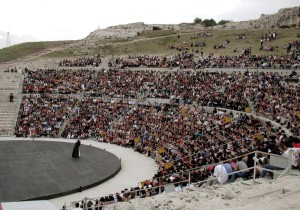Deft Communications specializes in helping our clients prepare for all manner of presentations, whether it’s going on camera as a spokesperson, delivering a keynote speech to a large auditorium, or simply conducting a small team meeting. This blog series will periodically provide best practices for any type of presentation you do.
I’ve stood in front of hundreds of people in a darkened auditorium with large video screens displaying my meticulously crafted PowerPoint presentation flanking me on either side, wireless mic attached to my lapel, booming sound system sending my voice into what felt like infinity.
I’ve also stood up at a round table seating 10 people, the warm fall air’s gentle breeze washing over everyone’s sunglass-adorned face, no notes in front of me, no sound amplification, only the fondness for my best friend and his new bride carrying me through the brief two minute presentation.
Which speaking engagement was I more nervous for? Beforehand – it was a tie. They both seemed equally daunting. In the moment, it was easily the second one. If that surprises you, you’re not alone. It surprised me, too, but I was ready for it. Why? Because I structured my speech to deal with that level of intimacy.
I wrote this speech to be structured in such a way, that if I got lost, got too emotional, looked too long at the groom’s crying mother, whatever… I could short circuit to the end without missing a beat and without anyone being the wiser. That’s exactly what happened. The groom’s mother started to weep, I got caught up in the emotion of what I was saying, lost my train of thought, and short circuited to the end.
It’s for that type of reason that it’s so important to understand your venue when you approach a speaking opportunity. I knew this would be a small affair – we were only the bride and groom’s 10 closest friends and family members – so I didn’t want to use notes, and I didn’t want to sound too formal. So I knew while writing that I’d have to write in a way that built in a failsafe in case I hit any snags. I did, and the speech turned out wonderfully. Tears streaked everyone’s cheeks, and they complimented me after it was over. It was a good feeling.
Compare this to the large auditorium situation. I knew the crowd would be large, I wouldn’t be able to see anyone, and that I’d have to practice, practice, practice. Amazingly enough, the fact that I couldn’t see anyone gave me comfort because outside of an errant cough or the reactions from my planned laugh lines, I felt much less exposed giving this antiseptic performance than I did while delivering a heartfelt speech to less than a dozen people.
That’s why considering your venue is so vital. Understanding the physical characteristics of your presentation space will – or at least should – shape how you write your material. Is it a large group or a small group? How large? How small? Are you expected to stand up and act as leader or remain seated at perhaps a conference table? Will you need a sound system? Is the audience solely live, or are there webcast attendees to consider? All of these things, taken in concert with the event’s purpose, will inform how you present.
You don’t drive your car the same way on the highway as you do in your neighborhood. Your presentation style shouldn’t be the same in all venues either. Learn as much as you possibly can in advance of your presentation about the room, the audience, the layout, and the physical characteristics of the venue, and then use that knowledge to create the best presentation possible.
Because whether you’re looking to make your best friend’s mom cry, or trying to keep the attention of hundreds of strangers, understanding your environment is a big component of achieving any of your communications goals.

Leave a Reply